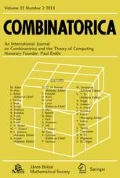Abstract
A Boolean function f: {0,1}n → {0,1} is said to be noise sensitive if inserting a small random error in its argument makes the value of the function almost unpredictable. Benjamini, Kalai and Schramm [3] showed that if the sum of squares of inuences of f is close to zero then f must be noise sensitive. We show a quantitative version of this result which does not depend on n, and prove that it is tight for certain parameters. Our results hold also for a general product measure µ p on the discrete cube, as long as log1/p≪logn. We note that in [3], a quantitative relation between the sum of squares of the inuences and the noise sensitivity was also shown, but only when the sum of squares is bounded by n −c for a constant c.
Our results require a generalization of a lemma of Talagrand on the Fourier coefficients of monotone Boolean functions. In order to achieve it, we present a considerably shorter proof of Talagrand’s lemma, which easily generalizes in various directions, including non-monotone functions.
Similar content being viewed by others
References
W. Beckner: Inequalities in Fourier analysis, Ann. of Math. (2) 102(1) (1975), 159–182.
N. Bshouty, J. Jackson and C. Tamon: More efficient pac learning of dnf with membership queries under the uniform distribution, In: Proceedings of the Twelfth Annual Conference on Computational Learning Theory 286–295, 1999.
I. Benjamini, G. Kalai and O. Schramm: Noise sensitivity of boolean functions and applications to percolation, Inst. Hautes Études Sci. Publ. Math. 90 (1999) 5–43.
M. Ben-Or and N. Linial: Collective coin ipping, In: S. Micali (editor) Randomness and Computation, Academic Press, New York, 1990.
A. Bonami: Étude des coeffients de Fourier des fonctions de L p(G), Ann. Inst. Fourier (Grenoble) 20 (fasc. 2) 335–402 (1971), 1970.
I. Dinur, E. Friedgut, G. Kindler and R. ODonnell: On the fourier tails of bounded functions over the discrete cube, Israel Journal of Mathematics 160(1) (2007) 389–412.
I. Dinur and S. Safra: On the hardness of approximating minimum vertex cover, Annals of Mathematics 162 (2005), 439–485.
J. Håastad: Some optimal inapproximability results, Journal of the ACM 48 (2001), 798–869.
N. Keller: A simple reduction from a biased measure on the discrete cube to the uniform measure, European Journal of Combinatorics 33(8) (2012), 1943–1957.
G. Kalai and S. Safra: Threshold phenomena and inuence, In: G. Istrate, A. G. Percus and C. Moore (editors), Computational Complexity and Statistical Physics 25–60, Oxford University Press, New York, 2006.
N. Linial, Y. Mansour and N. Nisan: Constant depth circuits, fourier transform and learnability, Journal of the ACM 40(3) (1993) 607–620.
E. Mossel and R. ODonnell: On the noise sensitivity of monotone functions, Random Struct, Algorithms 23(3) (2003), 333–350.
E. Mossel: A quantitative arrow theorem, Probability Theorey and Related Fields to appear.
K. Oleszkiewicz: On a nonsymmetric version of the Khinchine-Kahane inequality, Progress In Probability 56 (2003), 156–168.
M. Talagrand: On Russo’s approximate 0-1 law, Annals of Probability 22 (1994), 1576–1587.
M. Talagrand: How much are increasing sets positively correlated? Combinatorica 16(2) (1996), 243–258.
M. Talagrand: On boundaries and inuences, Combinatorica 17(2) (1997) 275–285.
Author information
Authors and Affiliations
Corresponding author
Additional information
Partially supported by the Adams Fellowship Program of the Israeli Academy of Sciences and Humanities and by the Koshland Center for Basic Research.
Supported by the Israel Science Foundation and by the Binational Science Foundation.
Rights and permissions
About this article
Cite this article
Keller, N., Kindler, G. Quantitative relation between noise sensitivity and influences. Combinatorica 33, 45–71 (2013). https://doi.org/10.1007/s00493-013-2719-2
Received:
Published:
Issue Date:
DOI: https://doi.org/10.1007/s00493-013-2719-2




